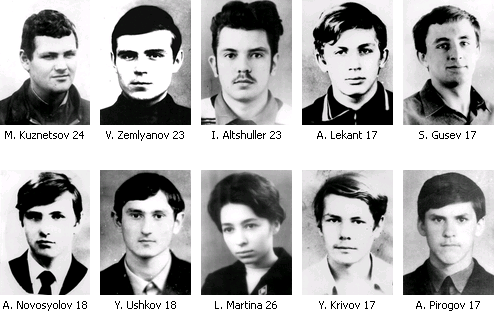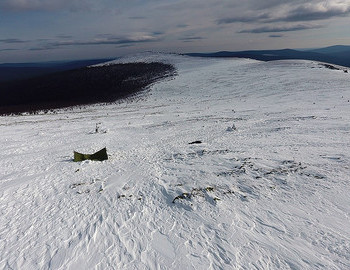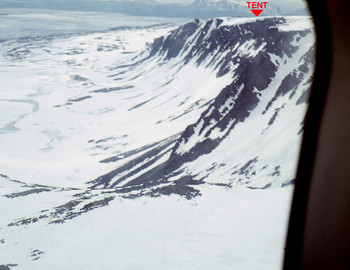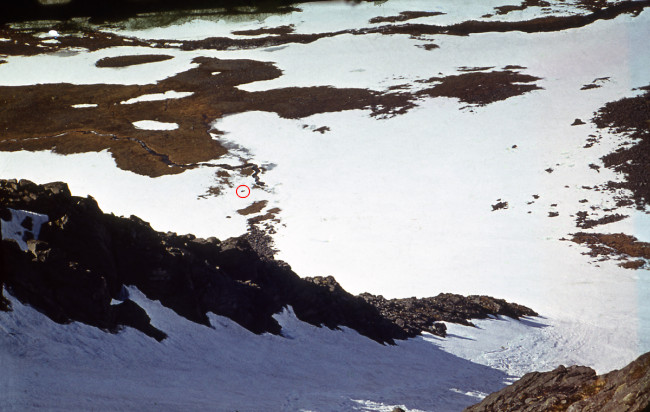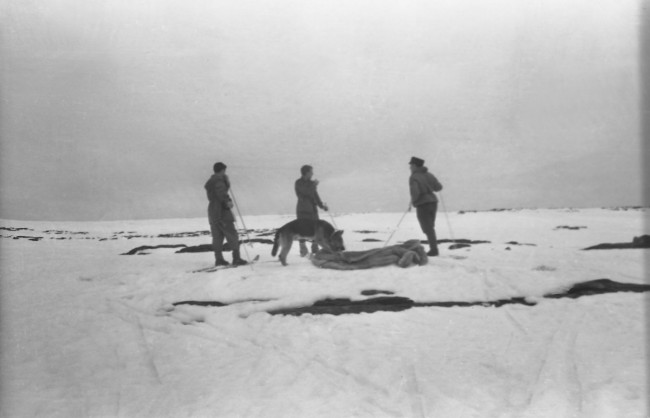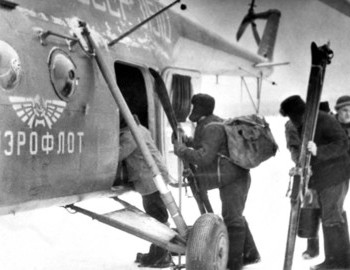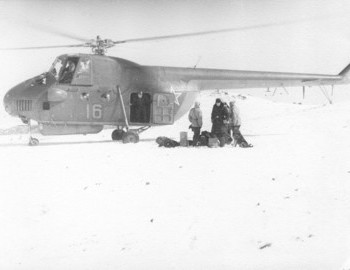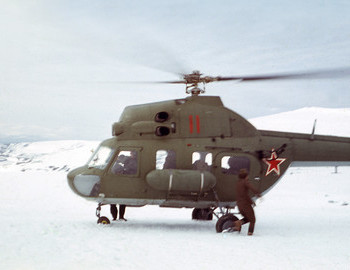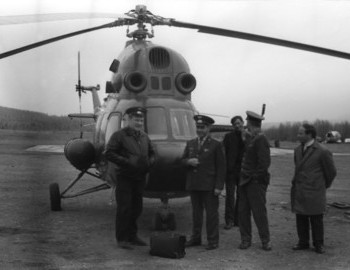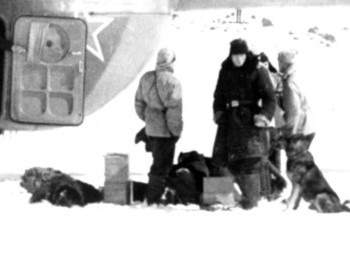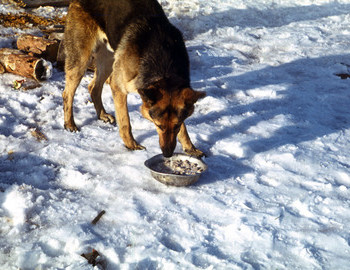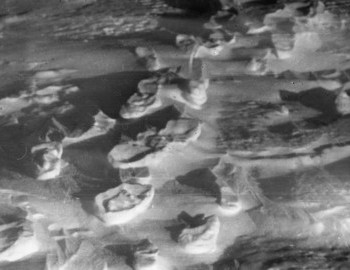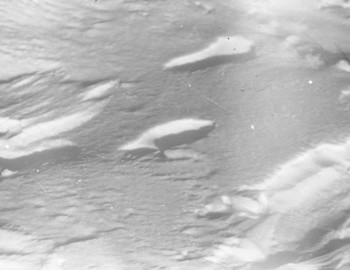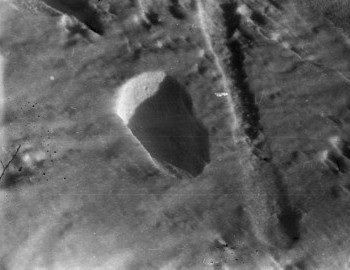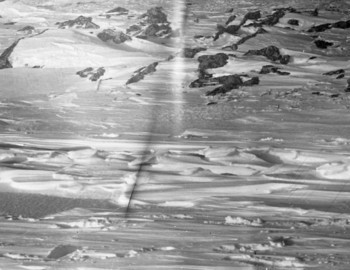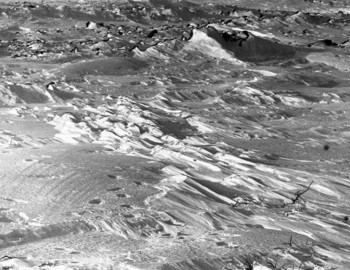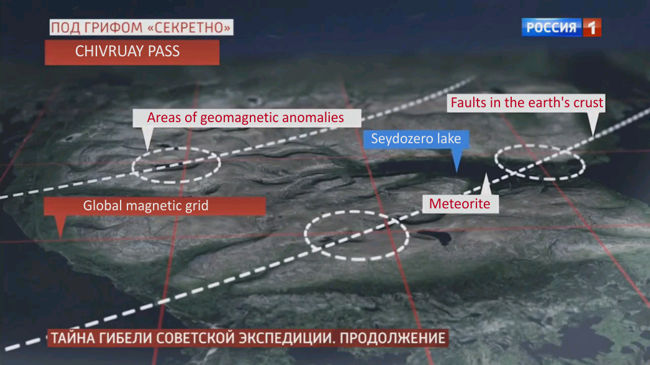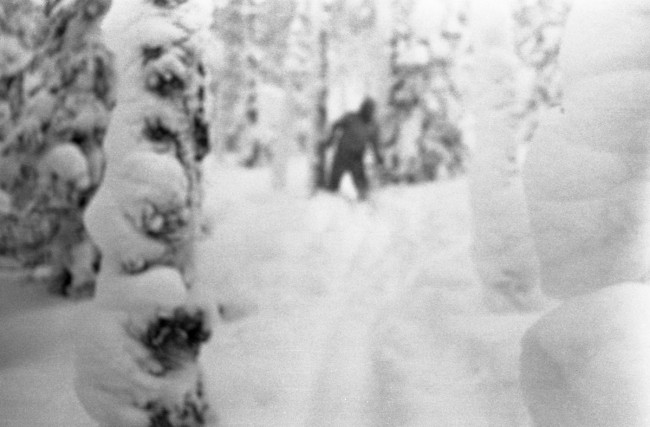
Dyatlov Pass incident vs. Chivruay tragedy
 Chivruay valley panorama by Dmitriy Novitskiy - Chivruay Pass is on the left, Seydozero lake is on the right.
Chivruay valley panorama by Dmitriy Novitskiy - Chivruay Pass is on the left, Seydozero lake is on the right.
This article is created after numerous exchanges with Vladimir Borzenkov an avid Dyatlov case researcher and member of the search party; he found some of the bodies in the 1973 Chivruay case. He sent me an article titled Chivruay 1973. How it really happened." prepared especially for DYATLOVPASS.COM. His appearance on the On Air Live (Pryamoy efir) with Andrey Malakhov*: They didn't return from the expedition: the mystery of the death of the Soviet expedition (part 1 and part 2) touched some nerves and I decided to share some of my observations and predictions.
* Andrey Malakhov was born in Apatity, Murmanskaya Oblast, of all places.
Table of contents
Introduction
The incident on Chivruay Pass is often compared to what happened to the Dyatlov group. Upon first glance from what we know neither group should've died. There is no apparent reason for the tragedy. There is no evidence of foul play or a forceful act that could explain the behavior of the seasoned hikers that led to their demise. They seem to have encountered "overwhelming force" indeed, but we can see no evidence of it. A snow storm doesn't leave a trace really, and the weather reports from January 26, 1973 point to a very cold front moving quite rapidly. The mystery on Chivruay Pass centers upon why the group split up. The Chivruay group had two leaders because the composition of the group was to consist of two groups. However, some students couldn't come because exams or other personal reasons so the remaining groups joined. Both leaders had covered this route before. The group was in good physical shape, all members had the required qualifications and equipment. Vladimir Borzenkov, a member of the search operation on Chivruay Pass and a very experienced hiker, stated that the route on which the group died was one of the most commonly used. More than ten groups from the Moscow Aviation Institute went to Chivruay Pass that season, and 300 groups in total traversed through Kola peninsula. The area is famous for unpredictable sharp changes in the weather. Vladimir Borzenkov is a first-hand witness. Here is an excerpt from Lukoyanov - Safety in skiing and extreme winter conditions (see p.122):
"In March 1963 a group from the Moscow hiking club "Spartacus" went through Chivruay-Ladv in the opposite direction - from Umbozero lake to Seydozero lake. Didn't have any problem scaling the steep slope of the cirque. They stopped for a break on top of the plateau. The March sun was warm. They were relaxed. Someone accidentally looked in the direction of the mine: an ominous cloud hung over the Elmorayok Pass. The edges of the grey mass swirled constantly changing its shape. The first gust of wind swept through the plateau. Then snow came blowing. The clouds were growing rapidly already closing half of the sky. The sun faded. The group hurried to the head of the northern stream. A strong gust of wind came over like a big wall. After a short lull, fury began. The snow hit as blast from a giant cannon.
The leader of the group, an experienced skier, G. Shapkin, insisted on stopping the descent and setting up a tent. Not all members agreed, but in the end the decision was made. For three days the group waited, huddled into the tent on top of the plateau for the blizzard to subside. They didn't carry primuses - portable stoves - and couldn't heat their food or melt snow. They had to dig out the tent from drifts many times. Their sleeping bags and clothes were wet. But they didn't fall into despondency and recklessness. On the morning of the fourth day, the March sun rewarded their endurance.
The group met a rescue squad in the forest of the Chivruay valley and they drank a bucket of hot compote. The rescuers showed wholehearted generosity. This case is described in details in their reports. Too bad it was not published. Maybe it would help others."
With this expose I have a double agenda. The initial goal is to lay down my perspective on the mysterious aspects of the Chivruay incident, and subsequently to point to a moment of deja vu. Seven years ago when I first started reading about Dyatlov Pass there was scarcely anything in English. After I started the site, without taking full credit, the information about Dyatlov Pass snowballed into a huge very and well publicized cold case. Movies, books, media coverage, forums, articles, and even tour guides advertising excursions to the pass with helicopters, snowmobiles, and dog sleds had sprung up. Mark my words - the same thing is now happening with respect to the Chivruay Pass incident. Two years ago when I first translated an article about the case and made the map with Deadly Passes, there was no information about the KuAI group case. Two years later, the same people that showed their faces on TV for Dyatlov Pass are now discussing the same theories about Chivruay Pass. In 2019 Victor Voroshilov, a KuAI group member's cousin, decided to do his own investigation into the incident. Victor was just gaining popularity and networking. He was charismatic and had the means to fund an expedition on his own. He was approached by the Russian Channel 1 to for an expedition to Chivruay Pass with a film crew. Two weeks before the start date, Victor Voroshilov was brutally killed. Speaking of mysteries, this certainly fueled the media channels with more speculations.
My point is that Chivruay Pass will gain popularity in the near future and we will see more parallels with the fascination with Dyatlov Pass. Let me give you the heads up of what to expect because to me this is a recipe for a winter horror. People seem to crave these type of stories. Ninety percent of what you will read in this article are the ramblings of a Mad Hatter. On the other hand, Alice in Wonderland is a marvellous book. Food for our imagination. Isn't this why we open a book or turn on a movie or a broadcast? Don't we need mystery? What if... Well, I want to try to at least give you some veggies with the popcorn - real information, so at least you have the facts right. They are not easy to obtain, either. Andrey Malahov had Vladimir Borzenkov in the studio, yet the dates on the screen were not even accurate. Try to be educational, not just sensational. I got many conspiracies from the show but not what really happened. I have to double and triple check my facts, correct them as new information emerges. And new information will follow via this method. What is now called secrecy regarding the file is basically a standard document record retention policy. The files are normally destroyed after a certain number of years. In the KuAI and Dyatlov groups' cases the investigation was really short. If you look at other cases of deaths in the mountains, there was no investigation, nor autopsies carried out. Even if a case was opened, it was usually closed without any resolution different from the usual -- death by exposure.
And yet, there is plenty of mystery in both cases. My goal is to give you the most information so you can focus on the real mystery here. I will make a parallel between both cases and give you the crazy similarities you will read about so I get the chance to publish comments from specialists next to them. It is unnerving when no matter how many times a fact has been addressed by a specialist the audience looks at them with blank eyes, turns around and keeps repeating the same nonsense over and over. I wanted to talk about the mask of horror on the faces of the dead in both the Dyatlov and Chivruay incidents but it became too much information for an introduction.
First thing first, let’s look at the basic facts about these two incidents that happened 14 years apart in remote mountain routes in harsh Russian winter.
Basic facts
| Dyatlov Pass | Chivruay Pass | |
| Other name | No name at the time of the incident | Chivruay-Ladv |
| Region | Russia, Sverdlovsk, Northern Ural | Russia, Murmansk, Lovozerskiye Tundry |
| Between | Auspiya river - Lozva river | Kitkuay river - Chivruay river |
| Altitude | 810 m | 830 m |
| Tent found at | 820 m | 890 m |
| Date of incident | Feb 1-2, 1959 | Jan 26-27, 1973 |
| Difficulty | III | II |
| Ski route day | 5 | 2 |
| Participants | 10 | 10 |
| Fatalities | 9 | 10 |
| Cause of death | 6 x hypothermia 2 x major chest fractures 1 x major skull damage | 10 x hypothermia one of them had signs of oxygen deprivation but died from hypothermia |
| Bodies' discovery and their distance from tent | 4 x Feb 27 › 2 x 1500, 1200, 870 m 1 x Mar 5 › 1020 m 4 x May 5 › 1575 m Map | 5 x Jan 28 › 0 m 2 x Mar 15 › 300 m 2 x Apr › 2 km 1 x Jun 1 › 150 m (80 m vertical) Map |
| Sports club | Ural Politechnic University (UPI) | Kuybyshev Aviation Institute (KuAI) |
| Leaders | Igor Dyatlov (23) | Mihail Kuznetsov (24) Valentin Zemlyanov (23) |
With both feet on the ground
Obvious similarities between the two incidents are multiple deaths in winter in remote mountains during cross country ski treks. Mountaineers find the following facts suspicious enough:
Location of the tents
Both incidents have tents pitched in bad places, especially when winds with the strength of a hurricane can literally appear out of a clear blue sky.
The Dyatlov group's tent was made from two tents sewed together to accommodate 10 people. It was found cut from inside rendering it unusable. This is one of the if not the most controversial points in the case. The tent found on Kholat Syakhl is thoroughly introduced on this site in the 1959 Search and Controversy.
The tent and stove were tested on previous treks. See photos of the same tent and stove on another trek. There was nothing wrong or experimental as some sources speculate. The stove was found dismantled and its case, i.e. it was not used as a heat source at the time they fled the tent.
You can take part in the discussion as well as find links to the testimonies regarding the tent on this forum board.
The KuAI group's tent was a military pavilion type. I especially inquired if it had a bottom because the way the first five bodies found it seemed they tried to cover themselves into the tent. It would be easier, I thought, if it had bottom. But it didn't. The tents were better suited to be hung in forests. Both, especially the KuAI tent provided little protection against strong winds out on the open plateau. Hence, I feel they didn't mean to stop there for the night but only for a break and the weather just stormed at them. Again, refer to the excerpt from Lukoyanov book. So what the guys did is sat on top of the tarpaulin and wrapped the tent around themselves like a taco. Kuznetsov tried to hold the two ends of the tent with a rope. The first thing the searchers found sticking out of the snow was his hand holding the rope. The upper part of the tent was in tatters. The hand was holding only a piece of rope. The bodies were not positioned as depicted on the model below. Vladimir Borzenkov who was present at the evacuation said that only Kuznetsov was flat on his back. The rest were huddled on their sides facing Kuznetsov.
Leaving the tent
The tent is your lifeboat in a life-threatening environment. Why leave it?
In the Dyatlov group's case (map) the guys seem to have been scared by something or someone and cut open the tent to flee. This one theory. Another theory is they went out to look at lights in the sky, even tried to take pictures, and someone marched them down the ravine to die. This same someone watched them from the tent going down (the small cuts) and then shredded the tent so the hikers can't use it as shelter in case they don't die. The footprints found suggest the hikers didn't run, stumble or do anything in a panic. This is weird. In either case, getting away from avalanche, Yeti or under duress, you would turn around at least once to see if it's chasing you. This is not indicated by the footprints. What happened to the Dyatlov group's tent is a complete mystery, even if we don't consider the fact that they were in their underwear. This is not paradoxical undressing because they left their clothes and shoes inside the tent. They didn't disrobe while dying from hypothermia. Well, they did kind of, clothes change hands, or let's say bodies. Here is table of who had what clothes.
In the KuAI group's case (map) the splitting of the group was not under such mind-boggling circumstances. Half of the group remained wrapped in the tent presumably because the winds were so strong, they couldn't prop it up. Vladimir Borzenkov said that the two groups that left the tent had to do it because it was very difficult to find the way down. It implies bad weather. But if the weather suddenly attacks you don't split up, read Lukoyanov again. To me there is no sense in putting a distance from you and the tent, without skis, because you can't get back, even with skis. This is a rule of thumb. I would say the weather got really bad after the scouts left the tent.
Here is another theory for why some remained on the plateau, and some went down. Tabris Sharafiev is a graduate of the Kuibyshev Polytechnic and an avid hiker. He knew many of the KuAI group members personally. For 12 years, Sharafiev worked in the weather service and wintered intermittently at various polar stations. "I think Altshuler was blown off a cliff by a strong gust of wind," Tabris Kavievich says. "This is the most likely reason why the whole group remained on the crest, and did not descent. They could not leave a friend. Part went to search, and part remained covered with a tent. Altshuler was found last in June. Under the cliff. Chivruay Pass is very tricky. The climb to it is gentle and in clear weather it seems that it is easy to go through it. But there are steep cliffs on the descent, and even in good visibility it is difficult to find the path. If a blizzard begins, they are in trouble." The problem with this theory is that the body of Altshuller was too far away from the cliffs to have fallen from a cornice, that they didn't even perform an autopsy, only external examination by a coroner in Kirovsk. This theory doesn't explain why L. Martina and A. Novosolyov traveled in the opposite direction of where Altshuller allegedly fell.
Paradoxical undressing
We find various degrees of disrobement and exchange of clothing in both cases.
In the case of the Dyatlov group the exchange of clothing is considered a grim time line of the order in which they died. Those still alive were "borrowing" pieces of clothing from their dead comrades. There is a lot of confusion even in the case files about the affiliation of the clothes found on the bodies. But one fact remains: most of the warm clothes and outerwear, as well as hats, gloves and shoes remained in the tent. No matter how you look at it this is inexplicable. Here is the link to the reference table of who was wearing what.
For the KuAI group I read for quite some time that the hikers found inside the tent didn't wear their warmest clothes, meaning they could've gotten extra sweaters, jackets etc. from their backpacks, and that Altshuller was not wearing gloves. He left the tent on a reconnaissance, right? Why did he leave his gloves behind? Another detail I read is that A. Novosyolov (18) gave his warm clothes to L. Martina (26), keeping only in his shirt. This is considered chivalry. But Vladimir Borzenkov says in his recollections that "the two showed signs of paradoxical undressing or vasodilatation syndrome". Another point Borzenkov made was that the five members of the group found inside the tent tried to put more clothes on and take out their sleeping bags out of the backpacks, but the wind blew all items away, and were found scattered all over the plateau.
The search
By the duration and complexity of the search operations, the number of dead - 10 people - the Chivruay tragedy surpassed the Dyatlov Pass incident. Air force was used in the both rescue operations.
The Dyatlov group search campaign was conducted with daily communication briefings through radiograms between the search party headed by Maslennikov, and the head of the Northern Geological Expedition Sulman.
For the KuAI group search we have an account of their routine from Vladimir Borzenkov, who was a member of the search party. They were talking on short wave radio stations to scheduled military flights flying above them and telling them what information to pass on the rescue service in Kirovsk. There were flights twice a week. If they needed something urgently, they had to send a man to Kirovsk. Since it was not safe to go alone two people had to do the trip.
Sappers with mine detectors were employed in both operations with no much success. They didn't find anything since the bodies didn't have any metal objects on them. In the Dyatlov group's case Lieutenant Colonel Shestopalov was leading a group of seven sappers. In the KuAI group search operation sappers from the Kandalash division combed the area. Search with mine detectors yielded no results in either case. Maslennikov wrote in his notebook: "Sappers will be more useful with probes, not mine detectors, as people under the snow do not have metal and metal items."
Dogs were brought in on both locations. They were doing much better on Dyatlov Pass than on Chivruay Pass.
The Dyatlov group search a dog Alta (or Alma) found Zina Kolmogorova on February 27. In general the dogs were feeling fine and stayed till May, but didn't find anything else.
In the KuAI group search Vladimir Borzenkov says that the military insisted on using dogs so a trainer was assigned with a rescue dog. Using dogs in the mountains of the Kola Peninsula in winter or on snow was not expedient. The mountains are volcanic rocks, which in many places have a porous and brittle structure on the surface. On the first day when the dog was brought to the pass and we showed her the belonging of the group, she was running all over the place in search. Because the items were so thoroughly wet, she was pouncing on everything wet, and could even pick up the smell. On the second day on the plateau the dog already had cut and bleedings paws. Dogs need to use boots in a terrain like this (ed. note: like the safety boots police dogs wear in hazardous environments to protect them from needles and broken glass). When she cut her paws, she looked so pitiful we sent her back to Kirovsk.
The footprints found on Dyatlov Pass are photographed and studied (read more). I don't have photos of the footprints on Chivruay Pass, only the recollections of Vladimir Borzenkov who took part in the search operation. "During the first, second, and third rounds of searches a lot of footprints similar to those in the Dyatlov Pass incident were found. To find tracks with clear direction and a pattern in the movement of people is very unlikely. On the Chivruay Pass 10 to 15 footprints located in different places were documented. We were unable to determine how many people left them. Very often the traces were not paired, consisting of one footprint and the other was nowhere to be seen. Trajectories of their movement were hard to establish, and we did this towards the very end of the search, when the highest number of traces were found, and only by statistical method. The trajectories can be considered simply probable, rather than definitive. For the record were entered the places of detection of the traces and belongings from the beginning to the very end of search. The condition of preservation of footprints was different. The tracks became visible either when the wind direction changed at the very beginning of search, or when the snow started melting towards the end of the operation."
The investigation
Both operations took long time. Search for the Dyatlov group lasted from February 20 till May 5 - two and a half months. Chivruay search started with the discovery of the bodies in the tent, before they were even missing, and continued until the body of Altshuller was found on June 1 - three months. In both search operations the lead investigator was present only at the beginning and then the interest in the case seemingly faded away. Investigations were short and superficial.
In the Dyatlov group case we have a special report of the CPSU dating March 27, according to which "it was established that the immediate cause of the death of the group was a large hurricane". When the last four bodies were found in the ravine with major chest and skull damage not only the course of the investigation did not change, but the bodies were not properly protocoled, their position, the items on them were not recorded either. The lead investigator had a hunch to test them for radiation and the next day after the results came positive on some items of clothing, he closed the case.
The recollections of Vladimir Borzenkov about the investigation for the KuAI group paints a similar picture of neglect. "When the previous two bodies were found (Lekant and Zemlyanov), the search team called the investigator to the site and waited for two or three days. When I read the protocol of discovering of the bodies, I noticed that city investigators were not able to describe accurately the place in terms of terrain forms and other landscape details. Even the orientation of the scene was approximate, probably it was done visually without a compass."
Malakhov says the cause of death was hypothermia, and the relatives were not convinced. We can see why this was true in the Dyatlov case, too many facts were not explained: the tent was cut from inside, the bodies were found in a state of disrobement, major chest fractures and skull damage which are injuries incompatible with life. In the Chivruay Pass incident there is nothing indicating foul play or mystery. All bodies froze to death, and all the searchers who found them are unanimous that they seem to have lost muscle tone, stopped, and died. Until Victor Voroshilov decided to go on the Chivruay Pass and get some more information about the death of his cousin, Anatoliy Pirogov, no one has ever questioned the incident. Yes, it was a tragedy, and their friends and family mourned them, celebrated their adventurous spirit and built a monument on Chivruay Pass. But it wasn't like the Dyatlov case full of unexplained facts and sightings, discrepancies and omissions in the case files, strange behavior of searchers and investigators, contradictory testimonies, and most of all - unexplained traumas, as if caused by a fast-moving vehicle according to the coroner Vozrozhdenniy, that lead to the death of three group members. Even the fact that only three of them had lethal injuries and none of the others is suspicious.
Classified files
People in Sverdlovsk never stopped talking about the Dyatlov case. Contrary to the rumors, the area was not closed, however, sports clubs were not eager to approve routes in the area. Subsequent to the deaths, the UPI hiking sports club administrators were reprimanded or fired. Almost immediately, the area was dubbed Dyatlov Pass. It was made official in 1962 when on the Kholat Syakhl mountain pass, a group led by Valentin Yakimenko set a memorial plaque saying: "In memory of those who left and did not return we name this pass after the Dyatlov group." This rebuts the claim that the pass was closed for hiking. It was just not encouraged. On one hand the administration was blamed for allowing the Dyatlov group go in a dangerous area, on the other hand same authorities are accused of conspiracy for not approving routes in the area right after the incident.
In 1966, Yuri Yarovoy, a journalist, who participated in the search and had to sign a non-disclosure on May 14, 1959, wrote a book based on the tragedy titled "The Highest Category of Difficulty".
Twenty plus years went by, and the coming of Perestroika allowed more independent ventures into the topic. The first documentary article by Stanislav Bogomolov about the death of the Dyatlov group appeared on October 31, 1989, under the title "UFO - Anatomy of a Secret”.
From July 8 to 12, 1990, the case files were cited for the first time publicly in the Ural Worker newspaper, where S. Bogomolov published "Mystery of the Fireballs (by Bogomolov)". The article included the Resolution for closing the criminal case and the admission of Lev Ivanov that he was ordered to close the case.
On November 22 and 24, 1990, the Leninskiy Put newspaper in the city of Kustanay, published "Mystery of the Fireballs" by Lev Ivanov, in which the former investigator apologized for his failings, and now claimed that the cause of the death of the Dyatlov group in the Urals were mysterious fireballs. No one understands or takes him seriously. He even wrote to Yeltsin, saying that his credentials were reliable and that more weight should be given to his insights.
The Dyatlov case files were officially published by the Dyatlov foundation in the form of a book in 2013. The Dyatlov foundation received an official copy of the case from the State Archive of the Sverdlovsk Region (ГАСО) in 2012. Before that in the 90s several books came out with quotations from the case files (Matveeva, Buyanov, Rakitin). Prior to that, in 1974, the case was transferred to the State Archive of the Sverdlovsk Region from the prosecutor's office archives. In the 80s, some people got an unofficial admission to the case. In 1989, the first unofficial copies were made.
More documents keep surfacing, some of them have the Classified stamp, others come from personal archives, like Tempalov's memo that was the centerpiece in the Dyatlov Annual conference in 2019, and it was given a proper explanation by the Prosecutor's office (same link), who had been investigating it for quite some time, since September 2018. Meslennikov notebooks, Grigoriev notebooks, all these personal logs could hold essential information for the case, and they still come to light now, 61 years after the incident.
The stories about participants in the search party being asked to sign a non-disclosure are preliminary disseminated by Korotaev, who has a big mouth. He makes himself sound as if he was the lead investigator, which he never was. Sharavin, a search group member, says he didn't sign anything. No one have seen any non-disclosure papers.
What happened to the tent? Does it still exist?
Head of Sverdlovsk Forensic Science Laboratory K. P. Kretov kept the tent. After Kretov died in the 80s the tent was taken to the garbage container, apparently water pipe burst back in the late 70s and the tent collected mold. The storage policy for evidence as well as case files is that they can be destroyed 25 years after the case is closed. Thank god the prosecutor of the Sverdlovsk region Vladislav Ivanovich Tuykov decided the case files not to be destroyed as "socially significant", but this did not apply to evidence. Some evidence was taken by relatives and later submitted to the Dyatlov Foundation established in 1999, but not the tent.
In Chivruay incident Malahov says in part 1 that they requested from Murmansk archives the KuAI group case files. They were given an answer that they will search for the related documentation, he makes the assumption that must have been an investigation if they are going to try to locate the file. Then they got the response, which he shows briefly on the screen:
"Prosecutor's office Russian Federation
Prosecutor's office Murmansk region
18a Commune St., Murmansk, Russia, 183038 tel. 47-22-66, teletype 126231 "Sever", fax 47-28-65
05/30/2019 №16-17-2019
Branch of FSUE STC "TV Channel"
«RUSSIA»
The main producer of the studio
for talk shows and prime time
Malakhov A.N.
37 Shablovka St., Moscow, 115162
The prosecutor’s office of the region considered your request for information on the fact of death on the territory of the Kola Peninsula on January 19, 1973 of the hiker skiers (students from the city of Kuibyshev (currently the city of Samara).
Also, it was established that the Ministry of Internal Affairs of the Murmansk region does not have any related information."
Malakhov says that this is strange because we all know that there was an investigation and the case files were classified for 75 years. Then he drops the bomb: Why classify if they died from hypothermia? Classic deflection. The question is not why classify but was there investigation at all. Borzenkov was the one who wrote the protocols of finding the bodies, why not ask him what was in the documents? He also said that all paperwork and evidence collected on cases without open investigation are destroyed after 25 years by law. This is a more probable reason why there is nothing in the Murmansk archives.
I watched closely what the camera does. Malakhov asks the question: "Was the leader of the KuAI group Kuznetsov involved in the search of Dyatlov group in 1959?" The guests in the show all sit next to each other. Borzenkov starts shaking his head and raising his hand because he knows personally all the members in the search groups, and most of the members of the KuAI group, but Nagaev takes the spot and says that Voroshilov gave all the answers in an interview. Again, deflection. Let's go on a goose chase for an interview with a dead person while Borzenkov is sitting right next to him and knows the case like the back of his hand. The only person who knows jack about the case - Borzenkov, is given the least time on the show. Eduard Tumanov, modern pathologist, very knowledgeable about the Dyatlov case had to fight to insert some common sense. His comments made this whole performance somewhat bearable. Three cheers for Tumanov! Malakhov tried for some diversity. But we ended up mostly listening to esoteric dreams (Svetlana Burenok), folklore (Valentina Sovkina), psychic vibrations (Albina Selitskaya) and Voroshilov's death, which had nothing to do with the case.
Watches in the Dyatlov group
| Dyatlov | Zvezda | 5:31 | Case files I - 121 | Autopsy: "On the lower third portion of the left forearm there is a Zvezda brand watch; the hands of the watch show 5:31." |
| Case files I - 69 | Maslennikov testimony: "On his hand Dyatlov was wearing a wrist watch that stopped at 5:31." | |||
| Case files II - 41 | Ivanov: "Zvezda wrist watch 5:31" | |||
| Case files II - 45 | Ivanov: "Zvezda 5:31 on Dyatlov" | |||
| Case files II - 46 | "I, A.A. Dyatlov received from Ivanov:... 5) A Zvezda wriswatch on a strap with arrows coated with luminous substance." | |||
| Slobodin | Pobeda | 8:45 | Case files I - 96 | Autopsy: "On his wrist is a Zvezda brand watch showing the time 8:45." Zvezda is mentioned only in the autopsy report. The rest of the documents read Pobeda and Slobodin owned a Pobeda. |
| Radiogram 183 | "On his wrist a watch Pobeda stopped at 8:45" | |||
| Case files II - 73 | "I, N. F. Slobodina received from prosecutor comrade Ivanov:...3. A Pobeda watch on a strap." | |||
| Thibeaux | Pobeda Sportivnye | 8:39 8:15 | Case files I - 341 | "...on his first hand are two watches, Pobeda and Sportivnye, the Pobeda shows 9:38, the Sportivnye 9:15" 9:38 is repeated once more in this document. Times on both watches are off by an hour, this must be an error. |
| Case files I - 352 | Autopsy: "On the left forearm there are two watches: a Sportivnye watch showing the time 8:14:24, and a Pobeda brand watch showing the time 8:39." | |||
| Case files II - 72 | "I Elizaveta Iosifovna Muzafarova,... received a Pobeda wrist watch... belonging to Nikolay Tibo." | |||
| Krivonischenko | Case files II - 9 | "I, Igor Alekseevich Krivonischenko received from Prosecutor comrade Ivanov:...3. Sportivnye wrist watch" | ||
| Zolotaryov | Case files I - 258 | "I, Vera Ivanovna Zolotaryeva, mother of Semyon Alekseevich Zolotaryov, received the following items from Prosecutor comrade Ivanov that student Sogrin handed over as belonging of my son: Pobeda wrist watch 1 MWF (Minsk Watch Factory) on a strap, in working condition..." | ||
| Kolevatov | Case files II - 50 | "Kolevatov's sister: My brother had a pocket watch, he fixed it, similar to the one here (Molniya)..." | ||
| "There is a pocket watch in the pocket of one backpack, which stopped at 2:15." "Vishnevskiy took the letter, the purse, money, diaries and watches." Kolevatov kept his watch in the pocket, while Zolotaryov wore his Pobeda on the left hand. This is why we attribute the time 2:15 to the Molniya. It was put in a backpack with all the items found in the tent and was later identified by his sister. This watch never made it into the inventory included in the case files. | ||||
| Kolmogorova | ||||
| Dubinina |
Find more information and photos of the watches in the Dyatlov group.
Watches in the KuAI group
| Mihail Kuznetsov Yuri Krivov Anatoliy Pirogov Sergey Gusev Yuri Ushkov | January 28 | 1:00 |
| Lidiya Martina Aleksander Novosyolov | March 15 | |
| Valentin Zemlyanov Artyom Lekant | April 27 | 4:33 |
| Ilya Altshuller | June 1 | 6:05 |
The following experiment was described in Borzenkov's memoir "Chivruay 1973. How it really happened."
While on the Chivruay pass in March 8-15, 1973, Borzenkov and the rest of the search team conducted experiments with the watches of the deceased. In both the Dyatlov Pass and Chivruay Pass incidents wrist watches found on the bodies stopped in a relatively short span of time, less than an hour of each other. Borzenkov: "We were trying to find the cause of this synchronous halt of movement. We took several different types of watches and started hanging them in the wind or putting them on the roof of the cabin. But the watches kept going until they unwound to full stop at different times. Then Anatoliy Ostrovskiy suggested putting them on ice. A body is an aggregate of bio-fragments consisting mainly of water and when it freezes it becomes a solid piece of ice. For our experiment we had five mechanical watches of different brands: Slava, Sportivnye (this was my watch), Vostok, Raketa, and a Japanese watch Seiko Sportmatic that belonged to a rescue worker who had traveled to Finland earlier.
All watches stopped at about the same time with a span of 30-40 minutes. The total running time was around 2.5 hours. This observation allowed us to determine the approximate time of death of most of the KuAI group members. If I remember correctly the time on the watches of the first five bodies was close to 1:00. There is no way of telling if it’s a.m. or p.m."
Borzenkov was again at the scene of the tragedy in May 23 - June 4 when the last body, that of Altshuller, was found. Then the last bit of information was obtained that Borzenkov needed for the conclusion of the experiment of the watches: "The last body was taken to the Kirovsk city morgue. After all the medical and legal procedures, it was transported to Kuybyshev.
We made the description of the items found according to the standard recommendations; we even had a photo of the corresponding page of the investigator's manual. There is one interesting thing I want to mention. When Yura Kozin was taking the items from the body and bagging them, he said something I remember clearly to this day: "On his left hand there is a wrist watch... which shows the time of 6 hours 5 minutes and 15... 16 seconds... What? It’s still going!" The only part I am not sure is the make of the watch and the seconds. The important thing was that the watch was still working after being removed from the frozen body. And this was the end of the experiment with the watches we started in March."
Smoke and mirrors
Toponymy and folklore
Do Otorten and Kholat Syakhl realy mean "Don't Go There" and "Mountain of the Dead"?
The legend goes that Kholat Syakhl is called "Mountain of the Dead" by the Mansi because nine Mansi hunters died mysteriously there. Others say they disappeared altogether.
We do our best not to let the legend die by adding nine dead helicopter pilots (see Untimely deaths below), and nine fatalities from an airplane crash that allegedly happened nearby. This last bit traces back to Chernobrov drawing and its most recent copy. You can read parts of his book "Ural Stalkers Flight from the Mountain of the Dead". It is not clear if there were three air crashes or all nine fatalities are from one. The only air crash that has nine fatalities happened in 1961 250 km (155 mi) away.
Mount Otorten is called "Don't Go There" because these mountains, especially the "gates" between them are considered sacred and dangerous since ancient times. They are guarded by spirits and you have no business going there, especially if you are a woman. The name of one mountain that appears on many photos taken by the Dyatlov group is Hoy Ekva meaning "No women allowed". See below Dyatlov Pass map with Mansi sacred places in orange.
The fact is that Kholat Syakhl is marked on the maps as Peak 1079. Mansi Холат-Сяхыл, Холе-Чахль, Холат-Сяхль, Холат-Сяхл, Холатсяхыл, Солатчахл. Kholat (Холат) means "meager", "lack of game", "dead", Сяхль (Syakhl) means "mountain". The Mansi word kholat (холат) is a relatively common name on their territory and is part of at least three other topographic objects.
Отортэн is the distorted name of Вот-Тар-тан-Сяхыл (Mt. Vot-Tar-tan-Syakhyl) meaning "The Windy Mountain", which is located several kilometers to the north and is inferior to Mount Otorten in height. Mansi call it Лунт-Хусап (Lunt-Khusap) meaning "Goose Nest" or Лунт-Хусап-Сяхыл (Lunt-Khusap-Syakhyl) meaning "Goose Nest Mountain". There is a Mansi legend that after the global flood, one goose survived on the peak of this mountain. The lake with the same name is located at the foot of the steep southeast slope of Mt. Otorten. The lake with the same name is located at the foot of the steep southeast slope of Mt. Otorten. It is from Lunt-Khusap-Tur Lake ("Goose Nest Lake") where the Lozva river originates.
The Devil's Pass
Valentina Sovkina, specialist in topology, a native of Lovozero: I have studied old maps of Kola Peninsula from the last century, or the beginning of this century. There are more names in the Sámi language than in Komi and Russian. Subsequently almost all names are changed or copied incorrectly. No one takes responsibility for it. In the past people called places based on landmarks and events that took place there. The Sámi Chivr-uay or Chivru-ayi as they pronounce it is spelled incorrectly. Here is a reference from the dictionary:
Чйввр (чйвр) II галька; мерр чйвр морская галька; чйвврэй берег здесь покрыт галькой
чйввьряй сказ. покрытый галькой; рыннт лй чйввьряй берег покрыт галькой.
Chyvvr (chyvr) || pebble; merr chyvr sea pebbles; chyvvrey pebble beach (riverside)
On the other hand:
Чиррм (чирм) II 1. дьявол, злой дух 2. эвф. волк. 2. эвф. волк.
Айе I, 4 быть занесённым (снегом, песком)
Вуайе I, 3 тонуть / утонуть, потонуть, затонуть, идти / пойти ко дну ;
Вуэйй (вуэй) I, 4 ручей; па?кь вуэйй горный ручей
Chirrm (chirm) || 1. devil, evel devil 2. fig. wolf
Aye I, 4 be covered (with snow, sand)
Vuaye I, 3 drown / sink the bottom
Vueyy (vuey) I, 4 stream; pank vueyy mountain creek
What if it had been changed intentionally since the Devil didn't exist in Soviet times, or the name was unintentionally misspelled? Instead of pebble river bank its original name might have been the Devil "burying you in snow", or "filling your eyes with sand", and "messing with your head" in general. We can start calling it Devil's Pass. Too bad there is already a movie by that name about the Dyatlov Pass. Renny Harlin chose that name because... and I quote "Dyatlov Pass means zero in terms of keywords; it has no marketing value; Americans won't remember or be able to pronounce it."
Dyatlov Pass map with Mansi sacred places in orange. You can uncluttered your view by selecting and deselecting the layers from the icon to the left.
Shamanism
«A shaman is only as good as the mushrooms he takes» - Eduard Tumanov
«Чем забористее мухоморы, тем круче шаман» - Эдуард Туманов
According to one theory the Dyatlov group was not just to traverse the taiga but also had the goal to find and get the Zolotaya Baba (Golden Woman). At least one of the members had allegedly this in his agenda, the most mysterious Zolotaryov. Before the expedition he made a strange statement, that after he gets back from the trek the whole world will speak about this expedition. Perhaps it was Vitaliy Abalakov who gave him the secret of Zolotaya Baba's location. The Golden Woman is a statue of an elderly woman with a baby in her lap made of gold weighing approximately 7.5 kg (16.5 lb). Inside the statue is a figurine of another male infant - a grandson, which is illuminated by an unknown light source. The Zolotaya Baba is the legendary idol worshiped by the peoples of the North.
The Zolotaya Baba is a technology that has not yet been discovered by modern mankind, transmitted to the northern peoples by representatives of a vanished civilization. According to the legend the Zolotaya Baba can predict the future. During World War II, the Germans hunted for the Zolotaya Baba, to no avail. According to researchers the Dyatlov group was supposed to track down the Zolotaya Baba, take it from the Mansi and deliver it to the Soviet authorities. Mansi figured out what the hikers were up to and brutally dealt with them. More serious injuries were received by Sasha Zolotaryov, Lyuda Dubinina and Kolya Thibault, because they directly saw the Zolotaya Baba or touched it. Besides the broken ribs and a caved in skull, Zolotaryov and Dubinina had their eyes gouged out and Dubinina also had her tongue torn out. In favor of this version are also numerous scraps of clothing found under the cedar that could be used for ritual purposes.

Dyatlov group died 5 days after they walked by this petroglyph on Lozva river
Vice President of the Astronomical and Geodetic Association of Russia, Sergey Smirnov, is a supporter of the theory that the Kola peninsula could be part of the mythical Arctic continent Hyperborea. He believes the group could've experienced the effect of "meryachenie" or simply lost their mind. "Meryachenie" in the language of the northern peoples is an unusual mental state associated with shamans and northern magic. The Eskimos call it the call of the North Star. Another word for it is Arctic hysteria. Sergey Smirnov says: "Meryachenie feels like mountain sickness, lack of acclimatization that happens when you are away from your permanent place of living. Consciousness is fogging, you start feeling the influence of the place, doing things that are not normal for you. In the nearby mountain Khibinskie Tundry I had lapse of memory, I thought I had a minor heart attack."
Malakhov inserts a comment that in the area electronic gadgets, GPS operated instruments and technology in general are unreliable.
I, T.H., the author of this article, witnessed the same problems while shooting the Discovery episodes on Dyatlov Pass. Very often the operator lost control over the drones. One time a drone took off on its own towards the forest and hit a tree. The operator sent a snowmobile to look for it and started putting away the equipment. The guys started shouting and the operator slowly turned around and saw the drone raising in the sky. He said that he wouldn't be more surprised if he saw Jesus rising. This was his closest encounter with AI.
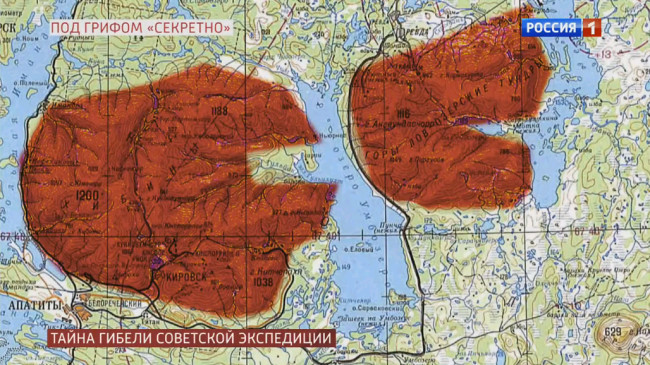
Khibinskie and Lovozerskiye Tundry as seen by Sergey Smirnov
Sergey Smirnov says that these are the imprints of the buttocks and private parts of two women sitting in these ancient mountain high grounds with their legs to spread out to East be caressed by the sun rays of Apollon. The larger area is 1300 sq. km (508 sq. mi).
Eduard Tumanov said a sexologist could explain why Sergey Smirnov was seeing female hips.
If you look closely at the KuAI route, the group went inside the big woman, like a reverse birth. Where have I seen this? I know, Queen of Sheba from "American Gods". In the movie the goddess (Gaiman describes her in the book as a half-demon) becomes satisfied, younger and more powerful.

Giant sign at the bottom of Seydozero lake
We can make fun all we want but the local folklore says just that. There is a cult complex on the Mount Ninchurt, identified as the sanctuary of the Great Goddess. The monument of the most ancient era is expressing the northern understanding of the "eternal" and is fully consistent with the Hyperborean times. At the foot of a steep cliff in the Chivruay gorge, a mysterious metal figure was discovered (spectral analysis showed an alloy of chromium and nickel), in shape resembling the famous ceramic figurines of the Great Mother. Mount Ninchurt itself also resembles the maternal womb. This circumstance, apparently, attracted here from ancient times all who worshiped the great beginning of all living things.
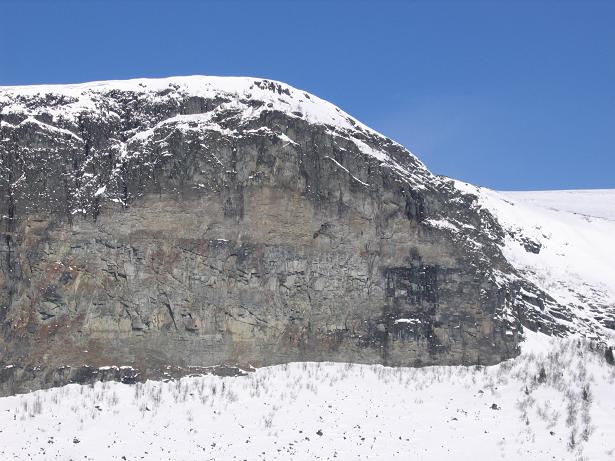
KuAI group died 2 days after they walked by the Kuyva petroglyph on Seydozero lake
See a panorama with the Kuyva rock at the very bottom of this page
You can read a lot of interesting information in English here Lake Seydozero. Traces of an ancient civilization. What I remembered is that the giant didn't like to be disturbed. If travelers were too noisy and disrespectful the giant could change the weather and kill them.
Yuliya Vopseva, who was born on the Kola Peninsula, believes that the valley next to the rock is damned. In 1965, four hikers died there, the cause of their death was never established. Vopseva studied archival documents, from which she learned that in 1937 Adolf Hitler sent members of the Ahnenerbe organization to these places to study mystical phenomena. (ed. note - the Ahnenerbe operated as a think tank in Nazi Germany between 1935 and 1945. Wikipedia). Stalin was convinced that this was a geological expedition, so he let German scientists into the USSR. There is a cave complex that to this day has German equipment. Yuliya Vopseva believes they were not looking for minerals but to uncover the mystical powers of the place. Why did the place cause such a panic in the group, why did the deceased had expression of horror on their faces (here we go again)? One explanation is that the caves could produce infrasound that causes disorientation and panic. See infra sound theory in Dyatlov Pass.
"This is a place of power with which you need to make adjustments - you must definitely enter the energy sector of this region," esoteric Svetlana Burenok is convinced. "The group went there treacherously. In winter, daylight hours are short, and at night the vibration of dark forces from another world increase," said psychic Albina Selitskaya. Valentina Sovkina, a resident of the village of Lovozero, believes in Sámi shamans, Noaidis, who can heal people and be guides to the upper and lower worlds.
Leonid Fyodorov, an electrical engineer, drew up a map of anomalous zones in Russia. He sees a connection between the tragedy on the Hamar-Daban ridge and the death of the Dyatlov group. According to him, in these places faults in the Earth's crust pass and the global rectangular grid of the Earth intersects, resulting in a strong pulsing electromagnetic field, which affects the human brain.
In the Dyatlov group incident there was electricity bursting in plasmoids which burned the extremities of some of the bodies. Plasmoid is a coherent structure of plasma and magnetic fields. Plasmoids have been proposed to explain natural phenomena such as ball lightning, magnetic bubbles in the magnetosphere, and objects in cometary tails, in the solar wind, in the solar atmosphere, and in the heliospheric current sheet. (Wikipedia)
KGB
Two participants in each group were older and more experienced than the rest of the group. Zolotaryov was a really strange bird, while Lidiya Martina just happened to work in a secret research institute. Back in the days to be recruited by the KGB or work in a secret plant wasn't so uncommon. We don't know for sure if Martina was an agent, there is a good chance that Zolotaryov was since his brother was a German spy and missing since the WWII, so being a KGB agent could be Zolotaryov's way of coping with the disgrace.
There is another scenario, too. It is common practice for the party organs to integrate a chaperone in hiking groups to observe their behavior so the free spirit of the mountaineers doesn't get the better of them and try to abscond. Usually this person had to be able to blend well since members of a hiking group usually knew each other from previous treks. A stranger could change the group dynamics. This is what happened with the Dyatlov group, but then "Sasha" Zolotaryov won their trust with smiles and songs.
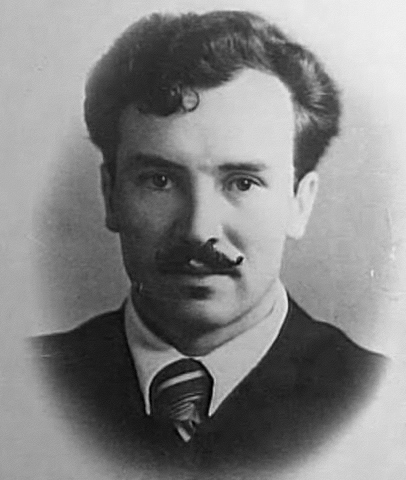
Semyon Zolotaryov
Graduated from the Institute of Physical Education in Minsk in 1950. Semyon was an instructor at Kourovska tour base at the time of his death. Zolotaryov was the oldest and also the most mysterious member of the group. He asked to be called Sasha and this is the name appearing in many documents and memoirs. In fact, his given name is Semyon. Before the very hike to Otorten, along with the group of Igor Dyatlov, Zolotaryov left Kourovska. Before joining the Dyatlov group Zolotaryov enlisted in the Sogrin group for a trek to Circumpolar Ural that would have lasted 25 days. Zolotaryov needed the Master of Sports title which would have reflected his pay and this trek could have given him the qualification. When he learned there was a shorter hike with the same category of difficulty, he transferred to the Dyatlov group. He was single, which was rather unusual for the time. Had tattoos and often mentioned gold capped teeth, which turned out to be no true after he was exhumed on April 12, 2018. Most of Zolotaryov's tattoos were hidden by clothing and the rest of the Dyatlov group didn't know anything about them.
The top seller on the Dyatlov case in Russia is Aleksey Rakitin's book in which he describes in great detail what Zolotaryov was probably doing on Otorten.
The superimposition performed by expert Sergey Nikitin at the cemetery comparing the skull with a known post war photograph of Semyon Zolotaryov shows perfect match.
The first DNA test results aired by Russian Channel 1 on May 16, 2018 exclude kinship of the person laying in Zolotaryov’s grave with Zolotaryov’s niece Tatyana Skulbeda, daughter of Semyon’s sister.
Second DNA test, this time conducted by such an authoritative scholar as Pavel Ivanov, showed the DNA of the person buried under the sign "Semyon Zolotaryov" matches the DNA of his niece. But this fact does not exclude the version other researchers suspected that under the name of Semyon his brother Nikolay could be buried, who, according to archival documents, worked with the Germans and disappeared without a trace during the war. Therefore, we cannot yet put an end on this investigation.
Komsomolskaya Pravda journalist Natalya Varsegova said there was going to be a third DNA testing in 2020, which will hopefully be definitive.
Semyon Zolotaryov has a surviving son who was most probably given for adoption. His fate and whereabouts are unknown to this day (more information).
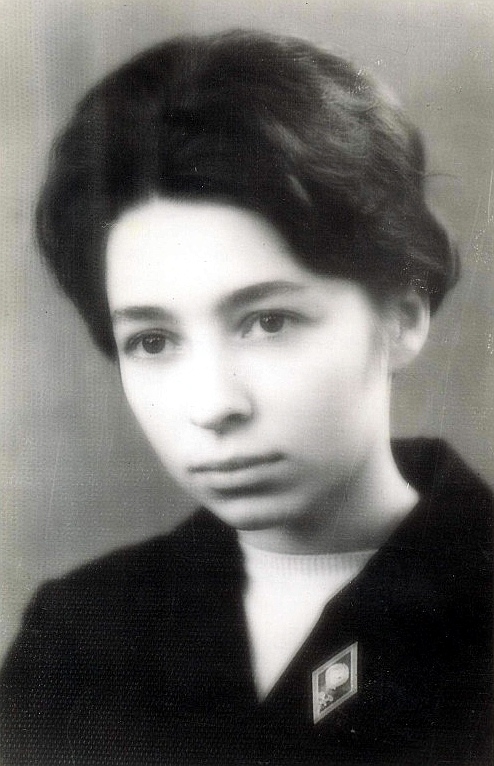
Lidiya Martina
Lidiya Martina was 26 years old. She worked at the Ekran secret research institute. Nagaev says the institute where Martina worked as an engineer developed the very devices the Dyatlov group had to test in the area of Mt. Otorten. He also says that Kuznetsov, leader of the KuAI group, took part in the search for the Dyatlov group in 1959, which Borzenkov denies. Lidiya Martina has been on many expeditions an had an extensive climbing experience. Galina Ildyuganova is a researcher of the Chivruay tragedy. Her biggest contribution to the show, which she leaves open to the imagination she had been unable to find Lidiya Martina mentioned in any archive. "This is food for thought," Ildyuganova says.
Participation of the KGB in the searches. In 1959 there were reports about military in black leather jackets carrying service weapons. Potyazhenko talks about them being present on the location before even the first bodies were found: "A small group of comrades in black sheepskin coats were on the ground, with a small tent already pitched in the forest i.e. there were people present already. It can be assumed that Ortyukov was in the dark about the big game, started by someone... Victor Potyazhenko was then a flight commander." Interview with Commander Potyazhenko
The Chivruay search operation had more resources in terms of time, manpower, and the air force. Malakhov asked why involve military and the KGB if there were no secret agendas, to which several people started saying at once that troops were always sent in to assist massive searches. The sports club couldn't support search groups for months. Someone said the Border Service of the Federal Security Service of the Russian Federation was always present at least until all bodies are accounted for.
Untimely deaths
In the aftermath of the terrible tragedy on Dyatlov pass and the mystery surrounding it, 26-year-old Sverdlovsk pilot Gennadiy Patrushev made an independent investigation into the causes of the death of the Dyatlov group.
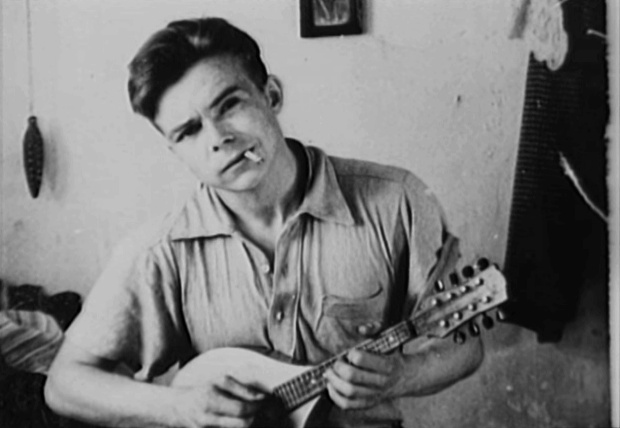
Gennadiy Patrushev, commander of a Yak-9 fighter
"He knew the students personally, met them in Ivdel, he warned them about the danger of the route to Otorten, and according to his account of events he first discovered their bodies on the mountainside. Judging by further tragic events concerning the fate of Gennadiy Patrushev he must have gone too far in his private investigation and seems to have got to the bottom of the truth, but he told no one about it." From an interview with his widow.
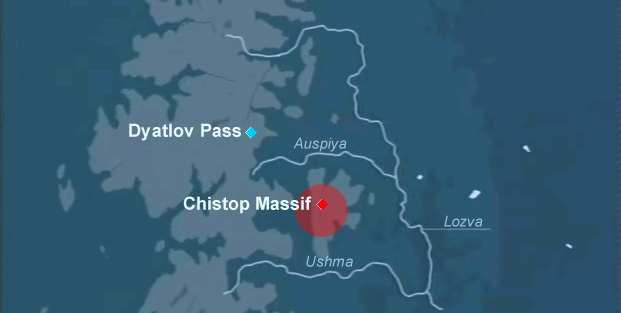
The area where nine pilots crashed between 1959-1961, Patrushev being the ninth
"Dyatlov Pass is rumored to always take a death toll of nine. The Dyatlov group were nine, then an MI-4 helicopter piloted by the commander of the crew Pyotr Gladyrev crashed, who at one time transported the bodies of the dead hikers in his helicopter. With the commander in the MI-4, four more people die, making total of five fatalities. After that an AN-2 plane crashes close by. The story is similar - the commander of an aircraft and 2 people perish. That makes eight fatalities. The ninth was Gennadiy Patrushev. He crashed his Yak-12 on May 22, 1961. It happened 65 kilometers north of Ivdel, that is somewhere in the area of the Chistop mountain range. More precisely, it is impossible to say, since the death of Gennadiy Patrushev was immediately enveloped in a veil of secrecy. The Mountain of the Dead is located 30 kilometers north of Chistop, but according to the version of Gennadiy Patrushev's widow that day the pilot allegedly visited the area of Dyatlov Pass. However, this is not proven. According to the official version Patrushev flew the Yak-12 from Ivdel to seed the forest in the taiga at low altitude. The plane collided with the tops of trees and crashed. Plane and pilot burned to the ground. But there is an unofficial version. Allegedly on that fateful day, Gennadiy Patrushev was transferred to another Yak-12, allegedly his plane to be repaired. And allegedly his technician Mihail Petuhov tampered with the elevator in this other Yak and made this treachery at the orders of the State Security. Petuhov was not tried, of course, and this version was not voiced anywhere."
"In search of the missing Yak"
In the Chivruay tragedy there is also an attempt for independent investigation that ended with an untimely death. Let's just say that being burnt alive is only a coincidence.
 Victor Voroshilov at Chivruay Pass January 31, 2019
Victor Voroshilov at Chivruay Pass January 31, 2019
Victor Voroshilov was a businessman from Nizhny Novgorod. He is the cousin of the same Anatoliy Pirogov whose twin brother we mentioned earlier. V. Voroshilov took upon himself to do his own investigation. He visited Chivruay Pass late January 2019. The media coverage of Russian TV 1 expedition to Dyatlov pass in March 2019 gave him the idea to contact the studio to do a similar campaign for Chivruay Pass. There was an interest and a new expedition was planned for October 2019. These episodes are drawn to be a parallel with Dyatlov Pass incident. Unfortunately Victor Voroshilov was killed and burned in his own car by a criminal disgruntled with his business two weeks before the beginning of his expedition with Russian Channel 1.
The criminal was apprehended. The first person on the scene says that Voroshilov was hit with a rock, put in the car and burnt alive.
Manufacturing company director brutally killed by unsatisfied customer
Valentina Voroshilova, mother of Victor Voroshilov, says when he returned from Chivruay Pass early in the year he told her he didn't know what happened to the KuAI group. He didn't have any information. On Malakhov's question to Valentina what she though happened to her nephew she replied she believed dark forces were to blame for the death of these young and strong men and women. The strangest thing for her is that the freezing hikers didn't touch the alcohol they brought with them.
Vladimir Pirogov, the twin brother says that although he helped his brother get clothes and other equipment, he himself is not a mountaineer. Voroshilov is survived by a son Ilya.
Mask of horror
Interview of Valentina Gamatina (Patrusheva), widow of Gennadiy Patrushev, continued from the paragraphs above "In search of the missing Yak":
After a very long interrogation, he said "they questioned me, then made me sign a non-disclosure" ... I finally understood what he was telling me. We went outside, walked along the street and he said "the guys still went, apparently, on the route that I advise them not to go. When we were raised on alert and flew, I remembered them discussing going there, and I flew in exactly the direction they must have gone. I saw the tent with slits and two bodies. The bodies lay with their heads to the tent. I could not set down, because the plane (he flew a Yak-12) could not land, there was no strip, so he gave the coordinates to the nearest helicopter, and they landed with the helicopters". He returned to the base, because he was running out of fuel. He saw these corpses. He said some time in March he flew with two corpses. Two corpses were in his plane. This Lyuda and Kolya, he called them only by name. And he said "I can't forget their faces. Their faces were distorted in some kind of horror." Then he flew away again and apparently decided to investigate on his own, because everything was shrouded in mystery.
I am not sure who first said that the KuAI group had expression of horror on their faces. Vladimir Borzenkov participated in over twenty rescue and search operations. The dead people he found looked dead, he says. None had a special expression, there is a feeling of "nobody home".
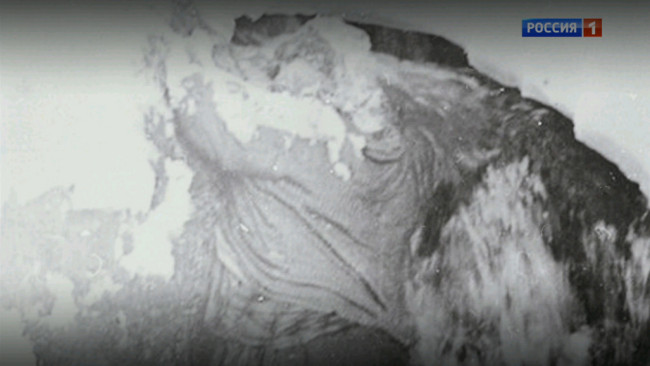
This is the photo showing on Malakhov screen when he said KuAI group members were found with expression of horror on their faces.
Actually, this is the photo of Lyudmila Dubinina found face down in the creek on May 5, 1959. What does she have to do with the KuAI group? Why use Dyatlov group photos for the Chivruay incident? It is true that we don't have the same photo arsenal as in Dyatlov's case. The Chivruay incident is only now picking up speed and I expect more material will become available, but for the time being let's just borrow from the Dyatlov case, is that it?
Here are some excerpts from forensic pathology literature and comments from experts that prove the dead mask of horror is a projection from the observers' imagination or state of shock, or even worse - from their appetite for sensation:
- Interview with Prof Dr Eva Scheurer, Head of Institute of Forensic Medicine at Basel University, Switzerland
Q: We are seeing on TV that next of kin has to identify the body.
A: The police are quite keen on this procedure but we aren't. Misidentifications happen all the time. A dead person has no facial expression and looks very different from a sleeping person. Sometimes even close relatives are unable to recognize their loved ones. They can often be in shock when someone had died suddenly or had been the victim of a crime. - Alex Eynon, EMT-Paramedic (2011-present)
Q: Have you ever seen somebody with an expression of horror?
A: People who die horribly do not have expressions of horror on their faces, and I have seen my share. - Forensic Medicine: Diagnosis and Signs of Death / Special Autopsy Techniques by Laszlo Buris: "Following death the musculature first goes limp and loses its tome. As a result, the temporomandibular joint relaxes and the wrinkles in the face smooth out due to atonic state of the facial muscles thus the body gives the impression of a younger person."
- Zoe-Anne Barcellos, Medicolegal Death Investigator: "I see dead people every day at work. And NONE of them has any expression on their face. Usually it looks like you would when you are asleep. I have seen people who have died in situations of terror when evidence at the scene reveals that they were aware of their impending deaths. I have attended deaths where people have died during intercourse- never saw an “O” face either."
- Eduard Tumanov, forensic pathologist: "I want to disappoint all those present, but the dead never have a mask of horror on their face, regardless of the cause of death. It never happens. It’s just a bad journalist’s cliche. I am a professional who works with dead people, I can responsibly assure you: no one ever has a mask of horror and this is just impossible."
No eyes
The repeating phrase in both cases is that the deceased do not have eyes. We heard Vladimir Pirogov, twin brother of one of the victims, Anatoliy Pirogov, what shocked him was the rapid change of color of the body when he was left in room temperature. No mentioning of missing eyes.
Nagaev says their eyes were burned from the radioactive content in the balloons of the emergency radiosondes that killed the group. His theory is explained in this section. He adds this is why they had to be buried in closed coffins, because of the radiation burns on their faces.

This is the photo showing on the Malakhov screen when he says the KuAI group are missing their eyes.
The Malakhov header contains a photo of Igor Dyatlov with the voice-over that some members of the KuAI group were missing their eyes "literally as if they were cut out from their faces". Using a photo from the Dyatlov group projects a parallel. Igor Dyatlov was not missing his eyes, but the photos of the ones that did (the four bodies found in May) were too graphic to show on a public channel. Eduard Tumanov has commented repeatedly when discussing the Dyatlov group that bodies found in a span of time from their death, out in the open, left to the elements and animals, very often are missing soft tissue, e.g. eyes, and in cases the tongue if the mouth is open. Vladimir Borzenkov was present when the first and the last bodies were found. He says there was nothing unusual, first bodies found the day after the incident were not missing anything, and one would naturally expect not much to have been left from Altshuller's face found three months after his death.
In the show the missing eyes are mentioned on one more occasion. Victor Voroshilov contacted Svetlana Burenok, an esoteric, she is a researcher of Lovozero region. Victor Voroshilov wanted to know if the spirits were favorable to his endeavor. He needed coordinates of the tragedy too. Burenok had a conversation that night with a Lovozero expert on the matter so she did go to bed as usual. She gets her questions answered between 2 and 4 a.m. but she was awake. She eventually went to bed and in the morning her daughter Polina Berezhnaya who is living in Moscow called her and said that an old man with missing eyes came in her dream last night and told her nobody was coming back, they were all going to die. Svetlana reassured her daughter this was not concerning them, and tried to warn Victor Voroshilov not to go to Chivruay Pass during the winter. He went there anyway. His family says that all his health (his vision deteriorated) and other problems (his wife didn't want to talk publicly about) started failing after having returned from the expedition to Lovozero. Victor talked to Svetlana Burenok on January 13, went to the pass on January 31, and was brutally killed on September 17, 2019, two weeks before his next expedition to Chivruay Pass with Russian Channel 1 and Malakhov.
Orange color
The fact that some of the bodies are buried in closed coffins is repeated in both cases as an argument for conspiracy. I don't think you want an open coffin of someone who has been dead for three months. There is an incident on Dyatlov Pass with Army Colonel Georgiy Ortukov involving closed zinc coffins.
Ortyukov and some soldiers took all the bodies from the stream, carried them up the bank and placed them on special stretchers to drag them across the snow, then took them up to the pass to the helipad. It was hard work, and they repeated the same process four times. A helicopter met them on the pass, but the pilots refused to take the bodies on board, complaining this was outside their official duties. It has been said that the pilots knew the bodies were poisoned with radiation and, for this reason, didn’t want them in the aircraft. Ortyukov sent the following radiogram:
This is a scandal! I and fourteen other people brought these bodies on our shoulders and they refused to take the bodies in spite of me insisting. As a Communist I am outraged by the behavior of the crew and ask you to inform the Communist Party leader about it. And I have to mention to you for clarity, these bodies are frozen.
We packed them for transportation and there was no reason to refuse to take them. The medical expert refused to examine or to cut the bodies here on site. It is absolutely nonhazardous from the point of hygiene. They are folded and covered in special impervious material. The crew said they would not transport them until they are in zinc coffins.
At this point Colonel Ortyukov reached the limits of his patience. He took out his pistol and threatened the crew. Vladimir Askinadzi intervened, after which the medical expert reorganized how the bodies should be packed for transportation, and they were finally airlifted for transportation to Ivdel.
Vladimir Pirogov, twin brother of one of the victims, Anatoliy Pirogov, says that when he saw his brother, who was usually with fair hair and completion, after hour-hour and a half, right in front of his eyes, his twin brother turned red, and his hair became whiter.
Same observations were made about the Dyatlov group. Witness testimony of Rimma Kolevatova given on April 14 (Case files pages 270-272). This is before the body of her brother was found: "I was present at all the funerals of the group. Why were their faces and hands all so dark brown?"
Lyudmila Morgunova, sister of Rustem Slobodin, says at 40:42 1TV 04/16/2013 that at the funeral she was close to the open coffin and her brother's skin color was like chocolate.
Yuri Kuntsevitch, head of the Dyatlov Foundation in Yekaterinburg, remembers: "At that time I lived next to the cemetery, and as a 12-year-old, I was really interested. I tried to push through the crowd to see everything, but it was impossible. I was amazed by some of the people in the crowd. They were wearing trilby style felt hats and had jodhpurs or motorcycle riding pants. They were supervising the procession with their faces blank, expressing nothing. I was standing on a pile of earth at the graveside and I was about eight meters from the bodies. Their skin had a somewhat brick color, and I saw some of the students helping to lower the coffins to the graves. It was said they were there despite being forbidden from leaving their classes to attend."
From Borzenkov's recollections: "It is necessary to note an important observation, very often referred to in the Dyatlov case, the red or orange color of the bodies. The discoloration is attributed to anything but natural causes (see #Orange). In fact, the recently extracted frozen body does have a reddish color, more accurately red-orange. It's a common occurrence in deaths due to cold.
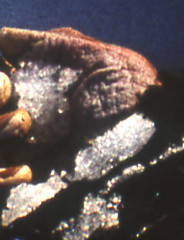
Detail of a recently extracted frozen body
The precise medical definition can be found in the Handbook of Forensic Medicine , it’s called frosty erythema or Keferstein stains."
Yeti
Frame №17 from Thibeaux Brignolle's camera shows a figure out of focus, but I can clearly see a trail. So this is not something or somebody that showed up from the trees and surprised the hikers, but somebody who went from the point where the photographer is by the trees and was probably coming back. Looks like a call of nature to me. Discovery Channel made a movie titled "Russian Yeti: The Killer Lives" in 2014, attributing the hikers' deaths to the shape in this photo.
- In Discovery's "Russian Yeti: The killer lives" Mike Libecki quotes a cryptic passage written in a newspaper the students brought with them "From now on we know that the snowmen exist". Me and Libecki were the experts in Expedition Unknown 2019. He told me this was taken out of context, that he read this while supposedly discussing different theories. The movie wrongfully portrayed him as a believer of this theory.
- Numerous sites simply misquote the Evening Otorten №1 paragraph. In the combat leaflet, where they typically "reported" humorous events, was this: "From now on we know the Snowmen exist. They can be found in the Northern Urals, next to Mount Otorten".
Apparently, the mass murdering Yeti wonders on the Kola Peninsula too.
The first nuclear explosion codenamed "Dnepr-1" was carried out in September 1972 in the Khibiny, in the depths of Mt. Kuelporr. The purpose of this experiment was to crush apatite ore using a nuclear explosion. Historian Andrey Vedyaev from the Special Services, was on location after the events. His expedition started from Revda (same as the KuAI group). A member of his group hung а damp shirt outside the tent in the evening. In the morning the shirt was found shredded. Their conclusion was it was not a bear because there were no tracks. Must have been a Yeti. Why doesn't a Yeti leave tracks was not explained. Andrey Vedyaev's main argument was the KuAI group wouldn't have started the ascent when there was barely any daylight and in bad weather unless scared by something. Another contradiction to point out here: Andrey Vedyaev said they pitched their tent on the top of the plateau, and allegedly the Yeti assaulted the shirt. So going up doesn't seem to matter to the Yeti. But then, he says, we have the horror on their faces when they were found dead.
Timofey Bazhenov, TV host and traveller, threw a piece of advice about hunting animals that must be applying to Yetis too, although he doesn't believe in Yeti. A predator never hunts against the wind. In the show there was no mentioning of wind direction. Lukoyanov (see p. 121) said the wind was behind them. Borzenkov said the wind was west-northwest, so it was blowing in their faces while ascending. I do not know whether Timofey Bazhenov's statement was true, but you never know when it might become handy. Timofey's argued the Yeti wouldn't follow them on top of the plateau because that would be against the wind. This doesn't make any sense because if the wind is blowing from your back the prey will smell you. I am totally confused as to where Timofey thought the wind was blowing from and his rule of thumb as a survivalist.
To this Malakhov added the KuAI group's splitting could be attributed to the Yeti.
Military experiments
Vladimir Nagaev, a veteran of the KGB and the Federal Security Service of Russia, head of the faculty of the Military Medical Institute and candidate of Medical Sciences published a trilogy in 2018, that reveals the mechanism of death of the Dyatlov group - "The half-life of the Khibina group" (vol.1 vol.2 vol.3).
— The Dyatlov group died while participating in a scientific experiment of national importance. They were launching special-purpose radio probes in an unpopulated area. Under the chloroprene shell of the balloon was a gas with short-lived radioactive isotopes - five-sulphur phosphorus. Meteorological rockets are known to have been used in the region of Mt. Otorten. At some point a missile must have hit one or more radiosondes and spilled the radioactive content.
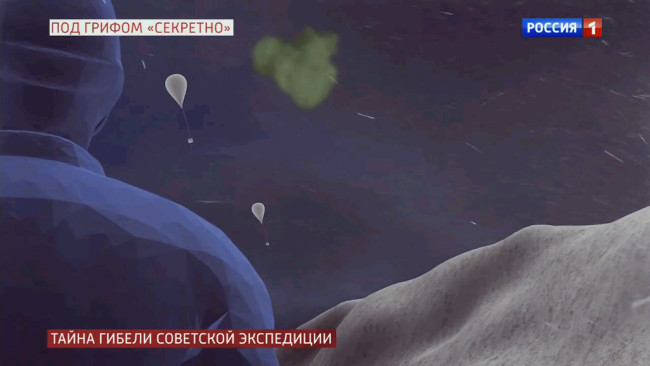
Dyatlov Pass: Military tests with radiosondes
After a certain time, some highly toxic chemicals (sulphur compounds for example) that enter a living organism are oxidized and quickly disappear from the body. It is proved that the process of oxidation of hydrogen sulphide in the blood occurs very quickly. About 99% of the hydrogen sulphide is gone from the body within 3-5 minutes. A toxic chemical element can be detected in the blood only if the rate of hydrogen sulphide intake equals or exceeds the oxidation rate. The final oxidation products that remain after death, such as sulphates, quickly decompose and cease to exist. A coroner may not detect the toxic chemical. However, traces of its effects remain in the organs of the corpse, for example, pulmonary edema, expansion of the borders of the heart, mainly the right half, fullness of organs, liquid dark blood. The Dyatlov group had signs of damage to internal organs by toxic chemicals, including organophosphorus compounds: pulmonary edema, changes in the borders of the heart (mainly the right half), plethora of organs, liquid dark blood.
Remember the sincere reaction of the criminal prosecutor Ivanov about the death mechanism of the Dyatlov group: "It was as if an air balloon had burst." As a result of the integrity of the shell of the balloon, radioactive gas (five-sulphur phosphorus) was in the environment with a radius of the affected zone of not more than 6 meters (20 ft). Under conditions of high humidity (snow mist), as well as ionization of the environment caused by radiation, began the formation of highly toxic sulphur dioxide gases, including hydrogen sulphide.
Search for the missing group was deliberately delayed. First bodies of the Dyatlov group were discovered almost a month after their death. This period corresponds to two half-lives of the radioactive isotope phosphorus-32.
— The cause of death of Kuznetsov group (KuAI group) in the Lovozerskiye Tundry are special-purpose emergency radio probes launched into the atmosphere from the Kola nuclear power plant (NPP).
According to Vladimir Nagaev, an emergency may occur during the operation of a nuclear reactor, the so-called xenon poisoning or iodine pit. The Chernobyl catastrophe happened because short-lived isotopes (xenon, iodine) were not removed from the reactor on time.

Chivruay Pass: Emergency radio probes from the Kola NPP
— I believe that in January 1973, an emergency radiation accident occurred at the Kola NPP in preparation for its operation. In order to prevent the explosion of a nuclear reactor the accumulated radioactive gases (xenon, iodine) are placed in soft gas tanks (chloroprene latex) and released into the atmosphere. This process happens automatically.
Nagaev further suggests that students and graduates of the Kuibyshev Aviation Institute could take part in some kind of scientific experiment, since most of them studied at the radio engineering faculty. He says that Kuznetsov, leader of the KuAI group, took an active part in the search of the Dyatlov group. Borzenkov says that this is not true.
The candidate of Medical Sciences Vladimir Nagaev explains that xenon under the conditions of ionization of the environment caused by radiation, actively interacts with oxygen and has a powerful narcotic phenomenon and analgesic effect. The stage of anesthesia (excitement) occurs very quickly, within a few seconds.
— It is proven experimentally that prolonged (several hours) exposure in a xenon atmosphere causes increased excitation and activity in animals. Body temperature rises! The searchers that discovered the bodies on Chivruay Pass were surprised to find the five dead hikers sitting on their backpacks in sweaters (they didn’t feel the cold), and all the warm outerwear was inside the backpacks.
To which Borzenkov replied that the mostly underdressed hikers - the five in the tattered tent did try to put more clothes but couldn't cope with the severe snowstorm. Their backpacks were open. Items were scattered all over the plateau.
Eduard Tumanov made a comment that the theory about radiosondes spilling poisonous gasses doesn't make any sense in the presence of hurricane winds over 50 m/s or 180 km/h (112 mph). There won't be any concentration or traces left to reach the skiers on the ground.
The author advocates the accidents that occurred on Mt. Otorten, on the Hamar Daban pass and on Khibinskie Tundry are of the similar nature hence the mechanism of death in all three cases is the same.
More...
- Khibina group
Did you know that the Dyatlov group called themselves Khibina group?
Evening Otorten
Zina's letter to Dyatlov from 16 Jan 1959
Khibiny is the mountain where the KuAI group's route ends. This is a strange coincidence, that we are comparing the incidents of two groups 14 years apart, and the first group called themselves by the destination of the second group. This is like the Kuznetsov-Zemlyanov group calling themselves Otorten group. - Women in the group
The presence of women in both expeditions could change the group dynamics and lead to unnecessary risks on behalf of the young men. - Whose fault it is
Galina Ildyuganova, introduced as a researcher of the Chivruay tragedy, who couldn't find the name of Lidiya Martina in any archive, said the chairman of KuAI Hiking section of the Sports Club didn't issue the correct documents for the expedition and was subsequently fired. We have the same situation with the UPI Sports Club. Leaders of the UPI were sanctioned. Here is the special report and the resolution to close the case with link to the part where it says who is at fault. - Names
The names of Yuri Krivo(nischenko) and Yuri Krivo(v) sound similar, as well as each group has a member with a French name - N. Thibeaux-Brignolle and A. Lekant. - Cadaveric spasm
Accelerated or instantaneous rigor (aka cadaveric spasm) is very rare if not a myth. The accounts below cannot be taken as highly credible.
Vladimir Askinadzi, a member of the Dyatlov group search party, recalls that when they dug out the last four bodies from the snow in May, Zolotaryov had a notepad in one hand, and pencil in the other. Colonel Ortyukov grabbed the notepad, looked at it, cursed and said: "He’s written nothing." Askinadzi is the only one that had seen the notepad. The whereabouts of this notepad is unknown, it was never filed in evidence or seen by anyone else. On the other hand, we hear only from Askinadzi about the whole episode with the pen, notepad and Colonel Ortyukov, and that 59 years after the fact in a recent letter of Askinadzi to Ural Pathfinder magazine
Vasiliy Kovalevskiy, a friend of the late Anatoliy Ostrovskiy, head of the Chivruay search operation, told him that Ilya Altshuller "froze with an unlit cigarette in his mouth and a lighter in his right hand." I asked Vladimir Borzenkov if this is correct since he was present when Ilya Altshuller was found. Borzenkov said he looked (in his personal archive) at the photos of the body when it was turned face up and he could confirm that Altshuller really didn't have gloves on his hands, but there was no cigarette or lighter in the picture.
- Alcohol
Neither of the groups drank the flasks with alcohol brought to the treks. This seems strange to some because there is a common knowledge that alcohol is going to warm you up. This is true if you are at the skating ring, but not if you are freezing to death. It is true that alcohol increases blood circulation. One of the mechanism of the body to cope with low temperatures is to limit the circulation of blood to the vital organs. This is why the extremities freeze first. If alcohol is introduced into the system cold blood can go into the core of the body and do more damage. Mountaineers know it.Here is a scene of that precious night when Slobtsov found the Dyatlov group's tent but not the bodies yet. It is the night of February 26, 1959.
... Several members started cooking dinner while everyone else was looking for clues how to continue the search the next day. They found 710 rubles and train tickets for the whole group. Most took this as a good omen. They assumed that criminals were not involved since they would've stolen everything of value. During dinner Boris Slobtsov raised a toast for the health of his friends and expressed hope that they would be found soon. Local forester, Ivan Pashin, was less optimistic about finding everyone alive and suggested they should probably drink for the dead rather than the living. Students found his words offensive and almost beat him up. The thought of their friends simply perishing like that in the Siberian Taiga was still incomprehensible. Such a short-lived hope. Four bodies were found the next day and the students were heartbroken.We don't know who drank the alcohol from the flask of the KuAI group, but we have the moment when Victor Voroshilov visited the Memorial on Chivruay Pass and raised a toast to his dear cousin and his friends. Little did he know he was going to join them soon.
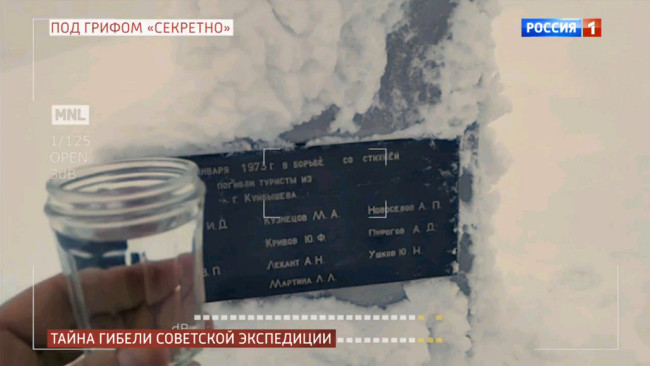
The Chivruay Memorial on 31 January 2019. Victor Voroshilov toasting the KuAI group
You can discuss this article in the forum.
 Seydozero lake panorama by Dmitriy Novitskiy - Kuyva petroglyph can be seen on the cliff to the right.
Seydozero lake panorama by Dmitriy Novitskiy - Kuyva petroglyph can be seen on the cliff to the right.


